
NGC 352 is a barred spiral galaxy in the constellation Cetus. It was discovered on September 20, 1784 by William Herschel. It was described as "pretty faint, small, irregularly extended" by John Louis Emil Dreyer, the compiler of the New General Catalogue; he also noted an "8th magnitude star 97 seconds of time to east" relative to the galaxy.
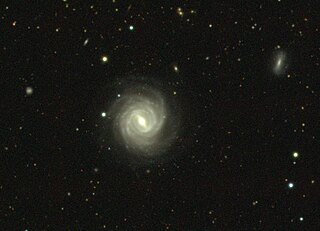
NGC 98 is a barred spiral galaxy in the Phoenix constellation. The galaxy NGC 98 was discovered on September 6, 1834 by the British astronomer John Frederick William Herschel.
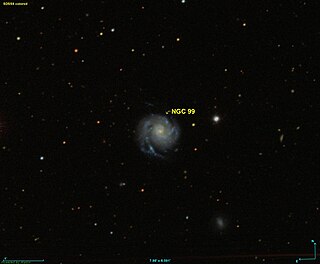
NGC 99 is a spiral galaxy in the constellation Pisces. It was discovered on 8 October 1883 by the French astronomer Édouard Stephan.

NGC 5985 is a spiral galaxy located in the northern constellation Draco. NGC 5985 was discovered by William Herschel in 1788.

NGC 81 is a lenticular galaxy estimated to be about 270 million light-years away in the constellation of Andromeda.

NGC 83 is an elliptical galaxy estimated to be about 260 million light-years away in the constellation of Andromeda. It was discovered by John Herschel in 1828 and its apparent magnitude is 14.2.

NGC 85 is an interacting spiral or lenticular galaxy estimated to be about 200 million light-years away in the constellation of Andromeda. It was discovered by Ralph Copeland in 1873 and its apparent magnitude is 15.7. The galaxy appears to be interacting with the companion spiral IC 1546.

NGC 86 is a lenticular galaxy estimated to be between 275 and 300 million light-years away in the constellation of Andromeda. It was discovered by Guillaume Bigourdan in 1884 and its apparent magnitude is 14.9.

NGC 96 is a lenticular galaxy estimated to be about 290 million light-years away in the constellation of Andromeda. It was discovered by Guillaume Bigourdan in 1884 and its apparent magnitude is 17.
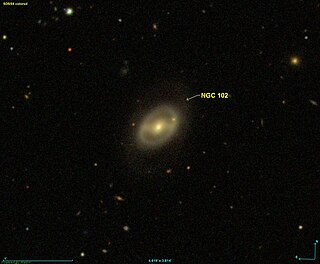
NGC102 is a lenticular galaxy estimated to be about 330 million light-years away in the constellation of Cetus. It was discovered by Francis Leavenworth in 1886 and its apparent magnitude is 14.
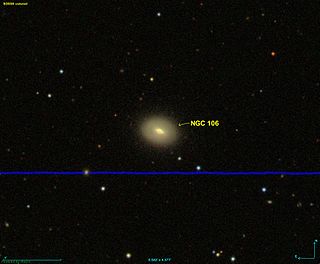
NGC 106 is a lenticular galaxy estimated to be about 270 million light-years away in the constellation of Pisces. It was discovered by Francis Leavenworth in 1886 and its apparent magnitude is 14.5.

NGC 107 is a spiral galaxy estimated to be about 280 million light-years away in the constellation of Cetus. It was discovered by Otto Struve in 1866 and its magnitude is 14.2.
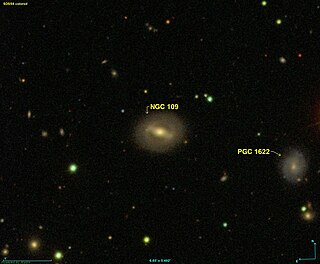
NGC 109 is a spiral galaxy estimated to be about 240 million light-years away in the constellation of Andromeda. It was discovered by Heinrich d'Arrest in 1861 and its magnitude is 13.7.

NGC 94 is a lenticular galaxy in the constellation Andromeda. It was discovered by Guillaume Bigourdan in 1884. This object is extremely faint and small. A little above the galaxy is NGC 96. NGC 94 is about 260 million light-years away and 50,000 light-years across.

NGC 5343 is an elliptical galaxy in the constellation of Virgo. It was discovered on 5 May 1785 by William Herschel.

NGC 150 is a barred spiral galaxy in the constellation Sculptor. It is about 70 million light years away from the Solar System, and it has a diameter of about 55,000 light years. It was discovered on 20 November 1886, by Lewis A. Swift. The Type II supernova SN 1990K was detected in NGC 150, and was reported to be similar to SN 1987A.

NGC 252 is a lenticular galaxy located in the constellation Andromeda. It was discovered by William Herschel in 1786.
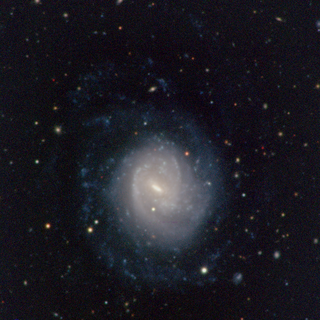
NGC 255 is a barred spiral galaxy in the constellation Cetus. It was discovered on November 27, 1785, by Frederick William Herschel.

NGC 257 is a spiral galaxy in the Pisces constellation. It was discovered on December 29, 1790, by Frederick William Herschel.
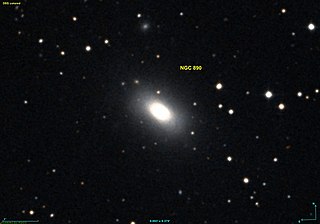
NGC 890 is a lenticular galaxy in the constellation Triangulum. It is estimated to be 180 million light-years from the Milky Way and has a diameter of approximately 130,000 ly. NGC 890 was discovered on September 13, 1784 by Wilhelm Herschel.



















